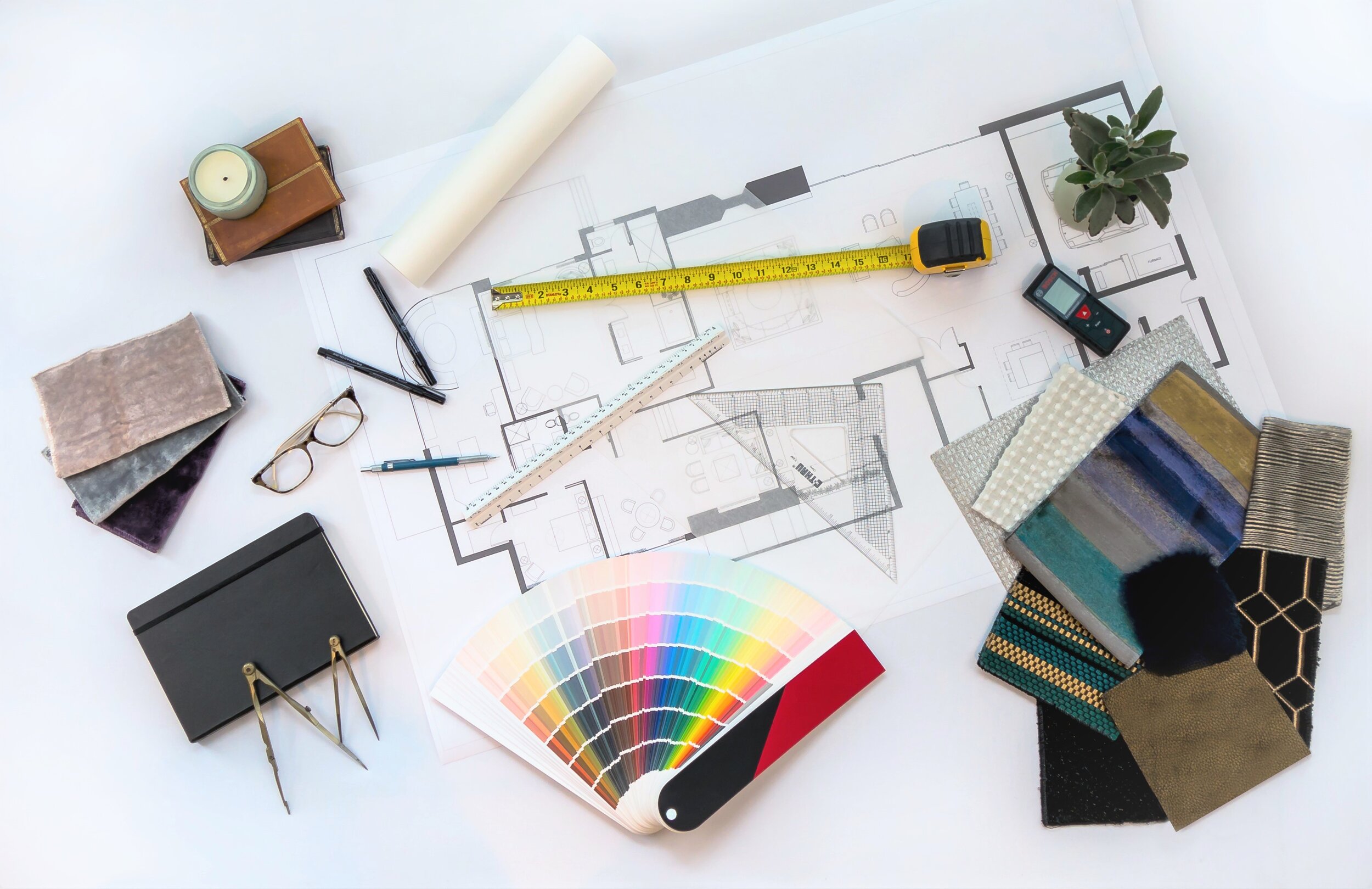
Tips for Selecting the Right White Paint Color and How to Use Them
With all the white paint colors out there, we do have some of our tried and true favorites that we start with as a baseline when meeting with our clients. Here are our top 5 favorite white paint colors.
In the world of interior design, few decisions are as seemingly simple yet surprisingly complex as choosing the right white paint color. While white may appear to be a straightforward choice, the reality is that there exists a vast array of whites, each with its own unique undertones, nuances, and effects on a space. As an interior design firm, we understand the importance of selecting the perfect white paint color to enhance the beauty and atmosphere of your living or working space. In this blog post, we delve into the intricacies of white paint selection, offering insights and tips to help you make an informed decision.
Understanding the Diversity of White
Contrary to popular belief, not all white paints are the same. In fact, the spectrum of white paint colors is incredibly diverse, ranging from warm, creamy tones to cool, crisp shades. Understanding the underlying undertones of white paint is essential for achieving the desired aesthetic in your space.
Warm Whites: Warm white paints often contain subtle hints of yellow, red, or brown undertones, creating a cozy and inviting atmosphere. These shades pair beautifully with traditional or rustic interior styles, adding a sense of warmth and character to any room.
Cool Whites: On the other end of the spectrum, cool white paints feature undertones of blue, green, or gray, imparting a clean and contemporary feel to a space. These shades are ideal for modern or minimalist interiors, offering a refreshing and serene backdrop for your décor.
Neutral Whites: Situated between warm and cool tones, neutral white paints strike a perfect balance, making them incredibly versatile and adaptable to various design styles. These shades are excellent for creating a timeless and harmonious ambiance, allowing your furnishings and accessories to take center stage.
Tips for Selecting the Right White Paint Color
Consider Natural Light: The amount of natural light in your space can significantly influence how white paint appears. Rooms with ample sunlight may benefit from cooler white tones to prevent the space from feeling too harsh, while rooms with limited natural light may benefit from warmer whites to add warmth and depth.
Test Paint Samples: Before committing to a white paint color, it's essential to test samples in your space under different lighting conditions. Paint swatches directly onto your walls and observe how the color changes throughout the day, from morning light to evening shadows.
Complement Your Décor: Take into account the existing furnishings, fabrics, and finishes in your space when selecting a white paint color. Choose a shade that harmonizes with your décor elements, whether it's enhancing the warmth of wooden furniture or accentuating the sleekness of metal accents.
Consult with Professionals: When in doubt, seek guidance from experienced interior designers or paint experts who can offer personalized recommendations based on your specific needs and preferences. They can help navigate the myriad options available and steer you towards the perfect white paint color for your project.
With all the white paint colors out there, we do have some of our tried and true favorites that we start with as a baseline when meeting with our clients. Here are our top 5 favorite white paint colors.
Our Top 5 Favorite White Paint Colors
Benjamin Moore: Super White
Why we love it: It’s a bright and crisp neutral white that doesn’t have undertones of any other hues. We love using this white on kitchen cabinets to create a light and airy effect.
Benjamin Moore: Super white
Benjamin Moore: NARRAGANSET GREEN
Designed by: Sarah Jacquelyn Interiors | Photography by: Dustin Halleck
Benjamin Moore: Dove Wing
Why we love it: A creamy, warm white with undertones of gray and yellow. This color pairs well with darker grays and nicely brings out the purple tones of Benjamin Moore Stone.
Designed by: Sarah Jacquelyn Interiors
Benjamin Moore: Dove Wing
Benjamin Moore: stone
Benjamin Moore: Chantilly Lace
Why we love it: Delicate like lace, this white is soft, clean, and works with almost any other color! We love using it on doors, decorative trims, and fireplace mantels.
Benjamin Moore: Chantilly lace
Photo Credit: Benjamin moore
Benjamin Moore: OC 151
Why we love it: A subtly warm white that added freshness to the room without being to harsh. We love using this on ceilings!
Photo credit: benjamin moore
Benjamin Moore: OC-151
Benjamin Moore: Decorators White
Why we love it: A timeless, classic white with cool undertones. This white is great for walls!
Benjamin Moore: Decorators White
photo credit: benjamin moore
Embracing the Power of White Paint
In conclusion, the selection of white paint color is a multifaceted decision that requires careful consideration of undertones, lighting, and design aesthetics. By understanding the diverse range of white shades and following these tips for selection, you can harness the transformative power of white paint to elevate your space with timeless elegance and sophistication. Whether you're aiming for a cozy retreat or a contemporary haven, the perfect white paint color awaits to bring your vision to life.
Need help selecting paint colors, finishes, or environmentally friendly products?
Get NCIDQ Certified in 2023!!
If you’re interested in learning more about the NCIDQ Exam, why it’s important, and how it can benefit you as a designer, you’re in the right place!
Hello! I’m so glad you are interested in learning more about the NCIDQ Exam! I’m Sarah Schwuchow, a Registered Interior Designer in Illinois and I passed the NCIDQ exam in the Spring of 2018.
I am also a CIDQ Ambassador, which means I help mentor exam candidates, educate students, and promote the value of NCIDQ certification to the public. I’m on a mission to help other designers pass the NCIDQ exam and become Registered Interior Designers!
If you’re interested in learning more about the NCIDQ Exam, why it’s important, and how it can benefit you as a designer, you’re in the right place!
It’s been 5 years since I earned my NCIDQ certification. This certification has benefited me in numerous ways, from opening my own business to having the confidence and knowledge to effectively communicate on a job site. This exam is not just for commercial interior designers; I use my NCIDQ knowledge every day as a residential interior designer and highly recommend all interior designers work towards this certification.
I always felt there was a need for more NCIDQ mentorship among the design community. After passing the exam, I looked into the CIDQ Ambassadors program where I could provide mentorship to candidates and educate Interior Design students on the value of the NCIDQ exam. I strive to be a resource to other designers, sharing my NCIDQ journey and encouraging them to take the exam.
I have helped many aspiring designers work towards this certification as well. In 2019 I created a study group through ASID to help designers pass the NCIDQ exam. Since then, the group has grown and we now partner with IIDA IL to broaden our reach.
Just starting to think about taking this exam can be a daunting task in itself! I’m here to help break down the requirements and get you on track for taking the exam. Keep reading below for step-by-step instructions on how you can become NCIDQ Certified.
Please note - the statements on this website are my own and not a reflection of CIDQ as an organization. This blog post is intended to be a supplementary guide for your NCIDQ journey. Please visit CIDQ.org for more information regarding qualifications, expectations, current prices, etc. Familiarize yourself with the CIDQ website, eligibility requirements, application process, registration process, and important dates and deadlines!
Application deadline
Applications for the Spring 2023 Exam needed to be
submitted by January 31st and July 31st for the Fall 2023 Exam.
Do NOT submit your application until you are ready to begin sitting for the NCIDQ Examination. Your testing windows are based on application approval.
What is NCIDQ Certification and Who is CIDQ?
CIDQ History
CIDQ was created by the American Institute of Interior Designers (AID) and the National Society of Interior Designers (NSID) in the late 1960s. The group officially incorporated as a not-for-profit in 1974 and was the basis for issuing credentials to Interior Design professionals. The AID and NSID would eventually merge to become what is now the American Society of Interior Designers. CIDQ went on to run as an independent organization, which administers the NCIDQ exam
What Does NCIDQ Mean?
The NCIDQ exam stands for the National Council for Interior Design Qualification. This is a globally recognized exam and the highest standard an Interior Designer can earn. The NCIDQ Exam was created by the Council for Interior Design Qualification (CIDQ). Once you pass all three sections (IDFX, IDPX, Practicum) of the the NCIDQ Exam, you become an NCIDQ Certificate Holder. You can then use the NCIDQ appellation after your name: Sarah Schwuchow, NCIDQ. The exam is offered for the entire months of April and October at Prometric Testing Centers. All three sections of the exam are now computerized.
Why Does NCIDQ Certification Matter?
NCIDQ Certification matters because it is an indicator of our proficiency and knowledge.
The Interior Design profession is still relatively young at only about 100 years old.
We are still working towards reasonable regulation, the title acts, practice acts, stamping abilities, and legislative rights for our profession.
NCIDQ Certification helps to create a standard to ensure designers have the knowledge, education, and experience to create spaces that meet codes, regulations, ADA requirements, health, safety, and welfare.
I am proud to be an NCIDQ Certified Interior Designer that can contribute to the development of the Interior Design profession as a whole.
From a legislative standpoint in Illinois, it is critical that we ensure the “Registered Interior Designers Act'' stays in effect, as many legal benefits come with this title such as lien rights.
In 2022, a major advancement in our profession was made. Governor Pritzker signed historic legislation that establishes practice rights for interior designers in Illinois. Read more Here.
10 Reasons Why You Should Take the NCIDQ Exam
NCIDQ Certification sets you apart from unqualified designers and decorators.
It is an indicator of your proficiency and knowledge.
NCIDQ Certification shows your commitment to the Interior Design profession.
You’ll earn respect among your colleagues, employers, and clients.
You’ll have the potential to earn more money and promotions, as many firms require NCIDQ Certification.
Increasing the number of registered/licensed designers elevates our profession.
NCIDQ Certification helps with legislation and Interior Design rights.
In Illinois, you must be an NCIDQ Certificate Holder to become a Registered Interior Designer, which gives you lien rights and practice rights now!
Registered Interior Designers in Illinois now have the right to file liens. Unregistered designers and decorators do not hold this right.
“To date, more than 30,000 people around the world have earned NCIDQ Certification, the gold standard for interior design professionals” (CIDQ.org).
What’s on the NCIDQ Exam?
“The strenuous requirements of the NCIDQ Examination give clients and employers added confidence in the caliber of work from NCIDQ Certified designers” (CIDQ.org).
The NCIDQ examination is no walk in the park. The level of difficulty proves that an NCIDQ designer possesses the knowledge and expertise for building systems, codes, construction standards, contract administration, design application, professional practice, and project coordination.
The exam is broken down into 3 parts: Interior Design Fundamentals (IDFX), Interior Design Professionals Exam (IDPX), and Practicum. Each section measures a candidate’s knowledge and proficiency on different topics related to health, safety, and welfare. All exams are taken during the entire month of April and October. Applicants have five years to complete all three exams.
Fundamentals Exam (IDFX)
Eligibility: Candidates can take this part of the exam before completing their work experience hours. This exam can be taken as early as a student’s final year of school for a Bachelors's or Masters's program.
Exam Format: 125 multiple-choice questions (100 Scored and 25 Pilot Questions)
Exam Length: 3 Hours
Application Fee for IDFX Only: $95.00
Registration Fee: $295.00
Testing Location: Remote Protectoring or Prometric Facility
Passing Score: 500 (Scores are weighted and on a scale of (200-800)
Professional Exam (IDPX)
Eligibility: Candidates must complete their education and work hours before applying for this exam. *WORK EXPERIENCE IS CHANGING IN 2024
Exam Format: 175 multiple-choice questions (150 Scored and 25 Pilot Questions)
Exam Length: 4 Hours
Application Fee for IDPX and Prac Only: $145.00
Application Fee for all 3 Sections: $225.00
IDPX Registration Fee: $355.00
Testing Location: Remote Protectoring or Prometric Facility
Passing Score: 500 (Scores are weighted and on a scale of 200-800)
Practicum (PRAC)
Eligibility: Candidates must complete their education and work hours before applying for this exam. *WORK EXPERIENCE IS CHANGING IN 2024
Exam Format: 114 Questions (105 scored, 9 Pilot Questions), Interactive computerized exam consisting of 3 case studies: large commercial, small commercial, and multi-family residential. No AutoCAD, or Hand Drawing.
Exam Length: 4 Hours
Application Fee for IDPX and Prac Only: $145.00
Application Fee for all 3 Sections: $225.00
Practicum Registration Fee: $460.00
Testing Location: Prometric Facility
Passing Score: 500 (Scores are weighted and on a scale of 200-800)
How Long do I have to Take the Exams?
ALL THREE SECTIONS: Must be passed within 10 exam administrations ( About 5 Years)
IDFX ONLY: Must be passed within 4 exam administrations + IDPX & PRACTICUM (2nd stage for IDFX ONLY applicants): Must be passed within 10 exam administrations.
Exam testing windows are April and October
Ready to Take the Exam?
Step 1: Eligibility Requirements
First things first—are you qualified to take the NCIDQ Exam? Visit the CIDQ website for full eligibility path requirements based your education and work experience. Work Experience will be changing for 2024!
Step 2: Create an Account
Before you can apply, you must create an account with CIDQ. Click here to register and then log in with instructions received in your email. If you have trouble, email inquiries@cidq.org for help.
Step 3: Applying for the Exam
There are two route options for applying for the NCIDQ Exam:
Option 1: Apply only for the IDFX. If you apply just for the IDFX now, you will need to submit another application for the IDPX and Practicum once you finish your work experience hours.
Application Fee for IDFX only: $95.00 (Second application for IDPX and Prac will be $145.00)
Option 2: Apply for all three sections.
Application Fee for all 3 Sections: $225.00
Applications are a one-time fee. Your application will also require you to submit an official transcript from your institution and your work experience (for IDPX & Practicum). Make sure you leave enough time for your sealed official transcripts to arrive, as any incomplete applications will not be considered after the deadline and you’ll have to wait until the next testing season.
Step 4: Registering and Scheduling Your Exam
Once your application has been approved, you will receive an email notifying you that you that can register for the exam and schedule a date at a Prometric Testing Center. Make sure to register early so you can lock in your preferred exam date!
From this point, you have 10 testing windows to pass all three sections of the NCIDQ exam. If you are only taking the IDFX, you must pass that exam within 4 exam windows. The second stage (IDPX and Practicum) must then be completed within 10 testing windows. Any scores older than 5 years are automatically voided. Registration fees occur each time you take an exam.
Exam Fees
IDFX: $295.00
IDPX: $355.00
PRAC: $460.00
Step 5: Studying
Make sure you leave yourself adequate time to study for this exam. I recommend at least 10 weeks and join a study group. Qpractice are ID Conquer are a great online resource to help you stay on schedule. Stay tuned for my upcoming blog post on my tips and tricks for studying for the NCIDQ Exam!
Join the more than 30,000 people around the world that have earned their NCIDQ Certification!
“Sarah has so much valuable knowledge and creativity to share as a designer. She will take the time to sit down and explain everything no matter what phase of the design process you are in. Sarah played a huge role in my success while studying for the NCIDQ. She was enthusiastic, motivating and genuinely cared. Working alongside Sarah and her team will make the entire process a positive and memorable experience!”
Bianka Daehler: ASID Illinois At- Large Director
We are excited to announce that our Senior Interior Designer, Bianka Daehler has been nominated and voted in as the At-Large Director for the ASID Illinois Chapter.
We are excited to announce that our Senior Interior Designer, Bianka Daehler has been nominated and voted in as the At-Large Director for the American Society of Interior Designers Illinois Chapter.
Her two year term will begin on October 1st, 2022. Bianka began her journey as an ASID member while in school at the Illinois Institute of Art Chicago. As she progressed in her career, Bianka realized that she wanted to pursue a path toward NCIDQ certification and rejoined ASID, which provided resources and connections to others on the same journey.
Interior Design rights and legislation sparked Bianka’s interest in pursuing a path of leadership. Her goals are to enhance the design community by increasing the number of Registered Interior Designers, provide resources for those pursuing NCIDQ certification, and help advance the legislative rights of interior designers. She plans to connect and collaborate with other organizations to unify the expansive Chicago design community.
Bianka currently serves as the Chicago Peer Group Leader, where she hosts monthly meet-ups for ASID designers and industry partners.
This is her last year studying for the NCIDQ exam. Upon passing the Prac exam this spring, Bianka will become NCIDQ Certified and Register with the State of Illinois.
ASID has so much to offer!
Interested in learning more about ASID? ASID members can get involved with committees and volunteer groups, attend peer group meetings, educational lectures and advocacy events, seek mentorship or become mentors, and learn leadership and professional development skills. We, as a design team, would not be where we are today without the support of the American Society of Interior Designers. We look forward to being able to give back in every way we can so we may continue to support the design community.
If you’re interested in becoming more involved in ASID, please reach out! Bianka@SarahJacquelynInteriors.com
Everything You Need to Know About the 2022 NCIDQ Exam
If you’re interested in learning more about the NCIDQ Exam, why it’s important, and how it can benefit you as a designer, you’re in the right place! I’m Sarah Schwuchow, a Registered Interior Designer in Illinois and I passed the NCIDQ exam in the Spring of 2018. I am also a CIDQ Ambassador, which means I help mentor exam candidates, educate students, and promote the value of NCIDQ certification to the public. I’m on a mission to help other designers pass the NCIDQ exam and become Registered Interior Designers!
Hello! I’m so glad you are interested in learning more about the NCIDQ Exam!
I’m Sarah Schwuchow, a Registered Interior Designer in Illinois and I passed the NCIDQ exam in the Spring of 2018.
I am also a CIDQ Ambassador, which means I help mentor exam candidates, educate students, and promote the value of NCIDQ certification to the public. I’m on a mission to help other designers pass the NCIDQ exam and become Registered Interior Designers!
If you’re interested in learning more about the NCIDQ Exam, why it’s important, and how it can benefit you as a designer, you’re in the right place!
It’s been 4 years since I earned my NCIDQ certification. This certification has benefited me in numerous ways, from opening my own business, to having the confidence and knowledge to effectively communicate on a job site. This exam is not just for commercial interior designers; I use my NCIDQ knowledge everyday as a residential interior designer and highly recommend all interior designers work towards this certification.
I always felt there was a need for more NCIDQ mentorship among the design community. After passing the exam, I looked into the CIDQ Ambassadors program where I could provide mentorship to candidates and educate Interior Design students on the value of the NCIDQ exam. I strive to be a resource to other designers, sharing my NCIDQ journey and encouraging them to take the exam.
I have helped many aspiring designers work towards this certification as well. As the 2019 ASID Illinois NCIDQ Committee Chair, I lead a study group of 5 designers towards NCIDQ success. Everyone in our study group passed their exams! Since then, the ASID Illinois Chapter has hosted a study group session every testing season and has even partnered with IIDA to broaden the outreach to the design community.
Just starting to think about taking this exam can be daunting task in itself! I’m here to help break down the requirements and get you on track for taking the exam. Keep reading below for step by step instructions on how you can become NCIDQ Certified.
Please note - the statements on this website are my own and not a reflection of CIDQ as an organization. This blog post is intended to be a supplementary guide for your NCIDQ journey. Please visit CIDQ.org for more information regarding qualifications, expectations, current prices, etc. Familiarize yourself with the CIDQ website, eligibility requirements, application process, registration process, and important dates and deadlines!
Applications for the Spring 2022 Exam needed to be
submitted by January 31st and July 31st for the Fall 2022 Exam.
What is NCIDQ Certification and Who is CIDQ?
The NCIDQ exam stands for the National Council for Interior Design Qualification. This is a globally recognized exam and the highest standard an Interior Designer can earn. The NCIDQ Exam was created by the Council for Interior Design Qualification (CIDQ). Once you pass all three sections (IDFX, IDPX, Practicum) of the the NCIDQ Exam, you become an NCIDQ Certificate Holder. You can then use the NCIDQ appellation after your name: Sarah Schwuchow, NCIDQ. The exam is offered for the entire months of April and October at Prometric Testing Centers. Remote proctoring is available for the IDFX and IDPX Exams. All three sections of the exam are now computerized- no hand drafting!
CIDQ History
CIDQ was created by the American Institute of Interior Designers (AID) and the National Society of Interior Designers (NSID) in the late 1960s. The group officially incorporated as a not-for-profit in 1974 and was the basis for issuing credentials to Interior Design professionals. The AID and NSID would eventually merge to become what is now the American Society of Interior Designers. CIDQ went on to run as an independent organization, which administers the NCIDQ exam
Why Does NCIDQ Certification Matter?
NCIDQ Certification matters because it is an indicator of our proficiency and knowledge. The Interior Design profession is still relatively young at only about 100 years old. We are still working towards reasonable regulation, title acts, practice acts, stamping abilities, and legislative rights for our profession. NCIDQ Certification helps to create a standard to ensure designers have the knowledge, education, and experience to create spaces that meet codes, regulations, ADA requirements, health, safety, and welfare. I am proud to be an NCIDQ Certified Interior Designer that can contribute to the development of the Interior Design profession as a whole
The NCIDQ exam was always a vital goal of mine and I admired design professionals who held the credentials. In the State of Illinois, you must be an NCIDQ Certificate holder to become a Registered Interior Designer. From a legislative standpoint in Illinois, it is critical that we ensure the “Registered Interior Designers Act'' stays in effect, as many legal benefits come with this title such as lien rights. I wanted to be part of the advocacy efforts, increasing our Registered Interior Designer numbers, and supporting the ASID and IIDA chapters who continuously educate the public on Interior Designs' impact on health, safety and welfare.
10 Reasons Why You Should Take the NCIDQ Exam
NCIDQ Certification sets you apart from unqualified designers and decorators.
It is an indicator of your proficiency and knowledge.
NCIDQ Certification shows your commitment to the Interior Design profession.
You’ll earn respect among your colleges, employers and clients.
You’ll have the potential to earn more money and promotions, as many firms require NCIDQ Certification.
Increasing the number of registered/licensed designers elevates our profession.
NCIDQ Certification helps with legislation and Interior Design rights.
In Illinois, you must be an NCIDQ Certificate Holder to become a Registered Interior Designer.
Registered Interior Designers in Illinois now have the right to file liens. Unregistered designers and decorators do not hold this right.
“To date, more than 30,000 people around the world have earned NCIDQ Certification, the gold standard for interior design professionals” (CIDQ.org).
What’s on the NCIDQ Exam?
“The strenuous requirements of the NCIDQ Examination give clients and employers added confidence in the caliber of work from NCIDQ Certified designers” (CIDQ.org).
The NCIDQ examination is no walk in the park. The level of difficulty proves that a NCIDQ designer possesses the knowledge and expertise for building systems, codes, construction standards, contract administration, design application, professional practice, and project coordination.
The exam is broken down into 3 parts: Interior Design Fundamentals (IDFX), Interior Design Professionals Exam (IDPX), and Practicum 2.0. Each section measures a candidate’s knowledge and proficiency on different topics related to health, safety, and welfare. All exams are taken during the entire month of April and October. Applicants have five years to complete all three exams.
Fundamentals Exam (IDFX)
Eligibility: Candidates can take this part of the exam before completing their work experience hours. This exam can be taken as early as a student’s final year of school for a Bachelors or Masters program.
Exam Format: 125 multiple choice questions (100 scored and 25 unscored pilot questions)
Exam Length: 3 Hours
Application Fee for IDFX Only: $95.00
Registration Fee: $295.00
Passing Score: 500 (Scores are weighted and on a scale of (200-800)
Professional Exam (IDPX)
Eligibility: Candidates must complete their education and work hours before applying for this exam.
Exam Format: 175 multiple choice questions (150 scored and 25 unscored pilot questions)
Exam Length: 4 Hours
Application Fee for IDPX and Prac Only: $145.00
Application Fee for all 3 Sections: $225.00
IDPX Registration Fee: $355.00
Passing Score: 500 (Scores are weighted and on a scale of 200-800)
Practicum 2.0 (PRAC)
Eligibility: Candidates must complete their education and work hours before applying for this exam.
Exam Format: Interactive computerized exam consisting of 3 case studies: large commercial, small commercial, and multi-family residential
Exam Length: 4 Hours
Application Fee for IDPX and Prac Only: $145.00
Application Fee for all 3 Sections: $225.00
Practicum Registration Fee: $460.00
Passing Score: 500 (Scores are weighted and on a scale of 200-800)
What’s New for 2022?
Interior Design Fundamentals Exam and Interior Design Professional Exam
The IDFX and IDPX are now available for remote proctoring! Remote proctoring is an exam delivery method administered by Prometric, CIDQ’s test delivery vendor, which provides candidates with the option of taking the IDFX or IDPX exams in a convenient location (i.e., at home) versus at a Prometric test center. Participating in a remotely proctored exam can only occur if your testing environment and computer systems meet Prometric requirements.
Practicum Exam
The Practicum Exam uses new codes, no longer will you use the 18 page NCIDQ codes for this exam. Instead, you will reference real life codes from IBC. You are not expected the completely memorize all of these codes, but should be familiar with them, know how to reference and apply the codes. Click here to view the codes!
Ready to Take the Exam?
Step 1: Eligibility Requirements
First things first—are you qualified to take the NCIDQ Exam? Visit the CIDQ website for full eligibility path requirements based your education and work experience.
Step 2: Create an Account
Before you can apply, you must create an account with CIDQ. Click here to register and then log in with instructions received in your email. If you have trouble, email inquiries@cidq.org for help.
Step 3: Applying for the Exam
There are two route options for applying for the NCIDQ Exam:
Option 1: Apply only for the IDFX. If you apply just for the IDFX now, you will need to submit another application for the IDPX and Practicum once you finish your work experience hours.
Application Fee for IDFX only: $95.00 (Second application for IDPX and Prac will be $145.00)
Option 2: Apply for all three sections.
Application Fee for all 3 Sections: $225.00
Applications are a one time fee. Your application will also require you to submit an official transcript from your institution and your work experience (for IDPX & Practicum 2.0). Make sure you leave enough time for your sealed official transcripts to arrive, as any incomplete applications will not be considered after the deadline and you’ll have to wait until the next testing season.
Step 4: Registering and Scheduling Your Exam
Once your application has been approved, you will receive an email notifying you that you that can register for the exam and schedule a date at a Prometric Testing Center. Make sure to register early so you can lock in your preferred exam date!
From this point, you have 10 testing windows to pass all three sections of the NCIDQ exam. If you are only taking the IDFX, you must pass that exam within 4 exam windows. The second stage (IDPX and Practicum) must then be completed within 10 testing windows. Any scores older than 5 years are automatically voided. Registration fees occur each time you take an exam.
Registration Fees
IDFX: $295.00
IDPX: $355.00
PRAC: $460.00
Step 5: Studying
Make sure you leave yourself adequate time to study for this exam. I recommend at least 10 weeks and join a study group. Qpractice is a great online resource to help you stay on schedule. Stay tuned for my upcoming blog post on my tips and tricks for studying for the NCIDQ Exam!
Join the more than 30,000 people around the world that have earned their NCIDQ Certification!
“Having an NCIDQ has helped me further develop my professional career in many ways. Overall, I look at new projects with better insight, knowledge, and have more confidence in the work I am providing to our clients.”
“NCIDQ validates you as a professional designer to your clients, peers, and the public.”
Our Favorite Decorative Hardware Right Now
Decorative hardware is the jewelry of the space! Whether you’re redesigning your entire home or just giving one of your rooms a refresh, use decorative hardware to add a little beauty and personality.
Decorative hardware is the jewelry of the space! Whether you’re redesigning your entire home or just giving one of your rooms a refresh, use decorative hardware to add a little beauty and personality.
Here are some of the pieces we are loving right now!
Modern Matter: Harrison Knob
Why we love it: It’s got texture, color, and character! We love adding metal accents to a make a design statement. Plus, it’s completely customizable; choose from eight gemstones and three different finishes. These vibrant colors are everything!
Modern Matter: Kravet Dylan Pull - Polished Brass
Why we love it: These pulls are sure to add luxurious vibes to any room. We love mixing metals into our designs and we are totally here for this polished brass.
AUZ Design Studio: Small Pyramid Square Knob
Why we love it: These modern square copper knobs add personality to any furniture piece. The finish is so unique and the textured lines on top are subtle and delicate.
Rocky Mountain Hardware: Emerald Cabinet Knob
Why we love it: This crafted hardware has exquisite detail with a handmade look. Perfect for kitchen cabinets in a traditional or transitional design.
Rejuvenation: Kennaston Drawer Pull
Why we love it: The sleek design of these pulls adds chic interest. We love the mix of leather and brass! These would be the perfect addition to a sophisticated kitchen.
Need help selecting the perfect decorative hardware for your home? Schedule a design consultation today!
The Custom Framing Process
Go behind the scenes with SJI to see how we design custom frames for our clients.
Ready to start your framing project with us? Schedule a design consultation today!
our top 5 favorite white paint colors and how to use them
With all the white paint colors out there, we do have some of our tried and true favorites that we start with as a baseline when meeting with our clients. Here are our top 5 favorite white paint colors.
People often ask us “What’s the perfect white paint color?” This is a difficult question to answer, because it really depends on your space, surrounding elements, lighting, and the design goals you are trying to achieve. Paint color should be the LAST element you select in your design. There are thousands of paint color options out there, and they vary by hue (color), value (lightness to darkness by adding black or white), and intensity (brightness or dullness by adding the complement color). Whites are particularly tricky because they often have undertones of blue, green, yellow, and red that can affect the look of your space.
Picking the perfect paint color takes a trained eye to understand all of the elements in the space and how they work together harmoniously. So I like to rephrase this question to:“ What is the perfect white paint color for your space?”
With all the white paint colors out there, we do have some of our tried and true favorites that we start with as a baseline when meeting with our clients. Here are our top 5 favorite white paint colors.
Benjamin Moore: Super White
Why we love it: It’s a bright and crisp neutral white that doesn’t have undertones of any other hues. We love using this white on kitchen cabinets to create a light and airy effect.
Benjamin Moore: Super white
Benjamin Moore: NARRAGANSET GREEN
Designed by: Sarah Jacquelyn Interiors | Photography by: Dustin Halleck
Benjamin Moore: Dove Wing
Why we love it: A creamy, warm white with undertones of gray and yellow. This color pairs well with darker grays and nicely brings out the purple tones of Benjamin Moore Stone.
Designed by: Sarah Jacquelyn Interiors
Benjamin Moore: Dove Wing
Benjamin Moore: stone
Benjamin Moore: Chantilly Lace
Why we love it: Delicate like lace, this white is soft, clean, and works with almost any other color! We love using it on doors, decorative trims, and fireplace mantels.
Benjamin Moore: Chantilly lace
Photo Credit: Benjamin moore
Benjamin Moore: OC 151
Why we love it: A subtly warm white that added freshness to the room without being to harsh. We love using this on ceilings!
Photo credit: benjamin moore
Benjamin Moore: OC-151
Benjamin Moore: Decorators White
Why we love it: A timeless, classic white with cool undertones. This white is great for walls!
Benjamin moore: Decorators White
photo credit: benjamin moore
Need help selecting the perfect paint colors for your space? Schedule a 2 Hour Paint Consultation with us today!
Get the Best Sleep Ever! Luxury Products for a Relaxing Bedroom
Improve your overall health, wellness, and quality of sleep this year with these luxurious sleep products that will make for the most relaxing sleep ever!
Quality sleep plays a vital role in our overall health and wellness. Sleep allows us to recharge our mind and body, leaving us refreshed and alert to start a new day! Sleep helps to repair our heart and blood vessels and sleep deficiency is linked in an increased risk of heart disease, kidney disease, high blood pressure, diabetes, and stroke.
Improve your overall health, wellness, and quality of sleep this year with these luxurious sleep products that will make for the most relaxing sleep ever!
1. Hästens Down Slipper Boots
These are one of my favorites and an absolute must have! Hästens Down Slipper Boots keep your feet warm during the cold Chicago winter nights. The material is so soft and breathable, it’s like wearing clouds!
$160.000
2. Slip Silk Pillowcases
3) Slip Silk Pillowcases help with wrinkles, bedhead, and sleep crease. Made with the highest grade of long fiber mulberry silk for softness and durability and no toxic dyes. We love the pink marble color way!
$89.00 Each/ Queen Size
3. Morgan Lane Sleep Lids Cashmere Mask Set
This Sleepy Lids Cashmere Mask Set is the perfect splurge to treat your self! Incredibly soft with an elastic bad for a comfortable and relaxed fit. Block out the light and sleep peaceful all night!
$198.00
4. Vitruvi Stone Diffuser
Designed to promote peace and relaxation, the Vitruvi Stone Diffuser in color Sea is one of our favorites to add ambiance to the bedroom! Add in a few drops of lavender essential oil create a serene oasis to melt away.
$119.00
5. Proper Sleep + Calm Tea
Proper Sleep + Calm Tea is for anyone struggling with falling asleep, staying asleep, or wants to reduce stress. It’s the perfect natural supplement to add to your wellness routine to support a restful mind and body.
$39.99
6. Hatch Restore Smart Light and Sleep Sounds
The Restore Smart Light and Sleep Sounds from Hatch can create a personalized routine to help you fall asleep, stay asleep, and wake up completely refreshed! Create a mood from a variety of soothing sounds and lights. Gently wake up to a custom sunrise alarm that supports healthy cortisol levels.
$129.95
7. Vispring Mattress
Invest in yourself by getting the best quality sleep every night on a Vispring Mattress. The perfect amount of softness and support. Melt away in this amazing mattress. Our favorite is the Vispring Lasalle.
Vispring LaSalle: $7,562.00 - $13,862
8. The Pillow Bar at Chicago Luxury Beds
Indulge in the perfect night sleep with a pillow made especially for you at Chicago Luxury Beds at The Pillow Bar. Their trained pillow makers will craft you a pillow for your unique sleep style, size and age.
$275 for One Queen Pillow
9. Sferra Millesimo Bedding
The Sferra Millesimo Collection is a lusciously soft, woven, polished sateen. Featuring an Italian lace inset, with a classic motif, this is luxury bedding at its finest.
$1,695 Queen Duvet Cover
$850 Flat Sheet
$695 Fitted Sheet
10. Luxome Weighted Blanket
This 30lb extra large weighted blanket from Luxome is engineered to help you relax and sleep better. Comes with a 100% Percale Cotton inner weighted blanket and removable cover that are both 100% machine washable.
$240
Need help designing your dream bedroom? Schedule a design consultation today!
WE NEED YOUR HELP: Support the Interior Design Profession by Creating a Witness Slip Now
We need your support to ensure the Registered Interior Designers Act is not eliminated. Supporting the profession is easy, and only takes a few seconds. Click for instructions!
The Illinois Registered Interior Designers Act is set to expire on January 1, 2022. If our Act is not extended by the legislature this year, it will be eliminated. HB 1738, currently in the legislature, will extend our Act to 2032.
We need your support to ensure our Act is not eliminated. Supporting the profession is easy, and only takes a few seconds.
Here’s how you can help:
No later than close of business on Tuesday (3/16), please do the following:
Click this link: https://www.ilga.gov/house/committees/hearing.asp?hearingid=17993&CommitteeID=2672
Click the light grey box at the top - “Create Witness Slip”
Scroll down to “HB1738 Nicholas K. Smith REGISTERED INTERIOR DESIGNERS”
Click the graphic that looks like a pencil and paper to the far right of “REGISTERED INTERIOR DESIGNERS”
Fill out ALL information boxes
For “Firm/Business Or Agency” you can put “Self” or your firm, business, or agency.
For representation, you can put your firm, business, or agency or “Self”
Position: select “PROPONENT”
Testimony: select “Record of Appearance Only”
Agree to terms and complete reCAPTCHA
Click “Create Slip”
Make sure you receive a success message.
SHARE THIS LINK WITH ANYONE WITH AN ILLINOIS ADDRESS. We need as many proponent record of appearance only slips as possible.
Thank you for Supporting the Interior Design Profession!
- Sarah Schwuchow, ASID, NCIDQ
Registered Interior Designer in Illinois
ASID Illinois President-Elect
I am excited to announce that I have been voted in as the President- Elect for the American Society of Interior Designers Illinois Chapter. My one year term as President-Elect will begin on October 1st, 2021 and I will serve as President for one year starting on October 1st, 2022.
I am excited to announce that I have been voted in as the President-Elect for the American Society of Interior Designers Illinois Chapter.
My one year term as President-Elect will begin on October 1st, 2021 and I will serve as President for one year starting on October 1st, 2022.
My goal as President-Elect is to bring a new and fresh perspective to the Chapter and the Illinois design community. ASID has been such an influential part of my career and I feel that it is my responsibility to give back and help others. I want to connect with our community to demonstrate the value of ASID membership and its impact on personal and professional development.
I hope to inspire our students, engage our emerging professionals, provide value to our professional members, and recognize our industry partners. I will strive for an inclusive community, highlight our members' diverse backgrounds, and motivate others to pursue paths of leadership.
We will create a community that shares, uplifts, and supports one another, ultimately increasing the awareness of our profession. As the Board of Directors, we will collaborate and communicate effectively to support the President's goals and endeavors. We will commit to improving our Chapter and ensure value for all of our members.
Serving as an ASID Illinois President has always been one of my goals.
Becoming an ASID Illinois Chapter President is a goal that I have had since I was a student member. I remember thinking to myself, what an honor it would be to one day serve on the ASID Illinois Board of Directors. Fast forward ten years later, I’ve achieved that goal as I’ve been serving as the Communications Director for the last year and I excited to start my term in October as President-Elect.
Joining as ASID was one of the most influential parts of my college experience.
I joined as a student member in 2010 after enrolling at the Illinois Institute of Art- Chicago. I was honored to serve as the Student Chapter President for FY11-FY12. With 6 Chapter officers and 22 additional members, our year was an incredible success, winning two ASID National Awards.
This leadership position was critical in forming my character, skill set, goals, and ultimate career success. I owe so much gratitude to ASID and I have strived over the last 10 years to give back and volunteer my time to help design students and my peers.
It is a personal mission of mine to help designers pass the NCIDQ exam and become Registered Interior Designers.
In 2019, I created the NCIDQ Committee for ASID Illinois. The purpose of the committee is to provide supplementary educational support and mentorship for NCIDQ candidates. As the Committee Chair, I lead weekly study sessions for the Spring 2019 testing season for 5 NCIDQ exam candidates. The participants of this study group were able to ask questions, learn new study techniques and benefit from the synergy of working with other design professionals.
After 8 weeks of intense test preparation, I am so proud to say we had a 100% pass rate for the exams each of these candidates took. This ASID Illinois NCIDQ study group has evolved into a partnership with IIDA and is now part of ASID Illinois’ regular offerings each testing season.
ASID has so much to offer!
ASID members can get involved with committees and volunteer groups, attend peer group meetings, educational lectures, and advocacy events, seek mentorship or become mentors, and learn leadership and professional development skills. I would not be where I am today without the support of the American Society of Interior Designers. I look forward to being able to give back every way I can, so that I can continue to support this community.
If you are a designer, student, or industry partner interested in becoming more involved in ASID, please reach out! I would love to have you attend a peer group with me or participate in a committee next year! Sarah@SarahJacquelynInteriors.com
10 Ways to Style Your Home with Vases
Accessorizing is the final layer when it comes to adding personality to your home. Even the most well designed spaces can look empty without the finishing touches added. One of our favorite ways to dial up the design is with vases. There are so many different styles, colors, materials, and textures to vases that when added, can easily elevate your home! Whether they are made of glass, porcelain, ceramic, wood, or even metal, vases can be just the thing to take your space to the next level!
Accessorizing is the final layer when it comes to adding personality to your home. Even the most well designed spaces can look empty without the finishing touches added. One of our favorite ways to dial up the design is with vases. There are so many different styles, colors, materials, and textures to vases that when added, can easily elevate your home! Whether they are made of glass, porcelain, ceramic, wood, or even metal, vases can be just the thing to take your space to the next level!
Here are 10 Ways to Style Your Home with Vases:
1) Make a statement in the foyer! Use an interesting, eye catching piece that will WOW your guests when they first walk in!
2) Decorate your living room coffee table! Remember the rule of 3’s when it comes making an arrangement. A decorative vase with flowers pairs well with a stack of books and a decorative tray.
3) Create a garden oasis in your living room! Go over the top with a big decorative vase and robust arrangement of flowers on the table.
4) The fire place mantel is calling! Use an assortment of two, three, four, our even five matching transparent vases with flowers to add airiness and natural elements to your mantel.
5) The kitchen island is a great place to bring in freshly picked flowers from the garden and add some style to the space.
6) Add visual height to a bedroom console by adding a tall sculptural vase, added flowers are optional!
7) Pick a vase with unique personality to use as a conversation starter when new guests come to visit!
8) Decorative vases are great for adding tactile and visual texture to a space, which creates a dynamic room design
9) Vases are perfect for bookshelves that need to be styled. A glass vase makes a great counterpoint and adds interest to wall full of books.
10) The dining room table is the perfect place for long stemmed vases. These vases leave a clear opening for your guests to talk across the table, while adding height to the space.
Need some inspiration?
Here are 8 gorgeous vases we are crushing on right now!
Need help accessorizing your home? Schedule a design consultation today!
Get NCIDQ Certified in 2023!
If you’re interested in learning more about the NCIDQ Exam, why it’s important, and how it can benefit you as a designer, you’re in the right place! I’m Sarah Schwuchow, a Registered Interior Designer in Illinois and I passed the NCIDQ exam in the Spring of 2018. I am also a CIDQ Ambassador, which means I help mentor exam candidates, educate students, and promote the value of NCIDQ certification to the public. I’m on a mission to help other designers pass the NCIDQ exam and become Registered Interior Designers!
Hello! I’m so glad you are interested in learning more about the NCIDQ Exam! I’m Sarah Schwuchow, a Registered Interior Designer in Illinois and I passed the NCIDQ exam in the Spring of 2018.
I am also a CIDQ Ambassador, which means I help mentor exam candidates, educate students, and promote the value of NCIDQ certification to the public. I’m on a mission to help other designers pass the NCIDQ exam and become Registered Interior Designers!
If you’re interested in learning more about the NCIDQ Exam, why it’s important, and how it can benefit you as a designer, you’re in the right place!
It’s been 3 years since I earned my NCIDQ certification. This certification has benefited me in numerous ways, from opening my own business to having the confidence and knowledge to effectively communicate on a job site. This exam is not just for commercial interior designers; I use my NCIDQ knowledge every day as a residential interior designer and highly recommend all interior designers work towards this certification.
I always felt there was a need for more NCIDQ mentorship among the design community. After passing the exam, I looked into the CIDQ Ambassadors program where I could provide mentorship to candidates and educate Interior Design students on the value of the NCIDQ exam. I strive to be a resource to other designers, sharing my NCIDQ journey and encouraging them to take the exam.
I have helped many aspiring designers work towards this certification as well. In 2019 I created a study group through ASID to help designers pass the NCIDQ exam. Since then, the group has grown and we now partner with IIDA IL to broaden our reach.
Just starting to think about taking this exam can be a daunting task in itself! I’m here to help break down the requirements and get you on track for taking the exam. Keep reading below for step-by-step instructions on how you can become NCIDQ Certified.
Please note - the statements on this website are my own and not a reflection of CIDQ as an organization. This blog post is intended to be a supplementary guide for your NCIDQ journey. Please visit CIDQ.org for more information regarding qualifications, expectations, current prices, etc. Familiarize yourself with the CIDQ website, eligibility requirements, application process, registration process, and important dates and deadlines!
Application deadline
Applications for the Spring 2023 Exam needed to be
submitted by January 31st and July 31st for the Fall 2023 Exam.
Do NOT submit your application until you are ready to begin sitting for the NCIDQ Examination. Your testing windows are based on application approval.
What is NCIDQ Certification and Who is CIDQ?
CIDQ History
CIDQ was created by the American Institute of Interior Designers (AID) and the National Society of Interior Designers (NSID) in the late 1960s. The group officially incorporated as a not-for-profit in 1974 and was the basis for issuing credentials to Interior Design professionals. The AID and NSID would eventually merge to become what is now the American Society of Interior Designers. CIDQ went on to run as an independent organization, which administers the NCIDQ exam
What Does NCIDQ Mean?
The NCIDQ exam stands for the National Council for Interior Design Qualification. This is a globally recognized exam and the highest standard an Interior Designer can earn. The NCIDQ Exam was created by the Council for Interior Design Qualification (CIDQ). Once you pass all three sections (IDFX, IDPX, Practicum) of the the NCIDQ Exam, you become an NCIDQ Certificate Holder. You can then use the NCIDQ appellation after your name: Sarah Schwuchow, NCIDQ. The exam is offered for the entire months of April and October at Prometric Testing Centers. All three sections of the exam are now computerized.
Why Does NCIDQ Certification Matter?
NCIDQ Certification matters because it is an indicator of our proficiency and knowledge.
The Interior Design profession is still relatively young at only about 100 years old.
We are still working towards reasonable regulation, the title acts, practice acts, stamping abilities, and legislative rights for our profession.
NCIDQ Certification helps to create a standard to ensure designers have the knowledge, education, and experience to create spaces that meet codes, regulations, ADA requirements, health, safety, and welfare.
I am proud to be an NCIDQ Certified Interior Designer that can contribute to the development of the Interior Design profession as a whole.
From a legislative standpoint in Illinois, it is critical that we ensure the “Registered Interior Designers Act'' stays in effect, as many legal benefits come with this title such as lien rights.
In 2022, a major advancement in our profession was made. Governor Pritzker signed historic legislation that establishes practice rights for interior designers in Illinois. Read more Here.
10 Reasons Why You Should Take the NCIDQ Exam
NCIDQ Certification sets you apart from unqualified designers and decorators.
It is an indicator of your proficiency and knowledge.
NCIDQ Certification shows your commitment to the Interior Design profession.
You’ll earn respect among your colleagues, employers, and clients.
You’ll have the potential to earn more money and promotions, as many firms require NCIDQ Certification.
Increasing the number of registered/licensed designers elevates our profession.
NCIDQ Certification helps with legislation and Interior Design rights.
In Illinois, you must be an NCIDQ Certificate Holder to become a Registered Interior Designer, which gives you lien rights and practice rights now!
Registered Interior Designers in Illinois now have the right to file liens. Unregistered designers and decorators do not hold this right.
“To date, more than 30,000 people around the world have earned NCIDQ Certification, the gold standard for interior design professionals” (CIDQ.org).
What’s on the NCIDQ Exam?
“The strenuous requirements of the NCIDQ Examination give clients and employers added confidence in the caliber of work from NCIDQ Certified designers” (CIDQ.org).
The NCIDQ examination is no walk in the park. The level of difficulty proves that an NCIDQ designer possesses the knowledge and expertise for building systems, codes, construction standards, contract administration, design application, professional practice, and project coordination.
The exam is broken down into 3 parts: Interior Design Fundamentals (IDFX), Interior Design Professionals Exam (IDPX), and Practicum. Each section measures a candidate’s knowledge and proficiency on different topics related to health, safety, and welfare. All exams are taken during the entire month of April and October. Applicants have five years to complete all three exams.
Fundamentals Exam (IDFX)
Eligibility: Candidates can take this part of the exam before completing their work experience hours. This exam can be taken as early as a student’s final year of school for a Bachelors's or Masters's program.
Exam Format: 125 multiple-choice questions (100 Scored and 25 Pilot Questions)
Exam Length: 3 Hours
Application Fee for IDFX Only: $95.00
Registration Fee: $295.00
Testing Location: Remote Protectoring or Prometric Facility
Passing Score: 500 (Scores are weighted and on a scale of (200-800)
Professional Exam (IDPX)
Eligibility: Candidates must complete their education and work hours before applying for this exam. *WORK EXPERIENCE IS CHANGING IN 2024
Exam Format: 175 multiple-choice questions (150 Scored and 25 Pilot Questions)
Exam Length: 4 Hours
Application Fee for IDPX and Prac Only: $145.00
Application Fee for all 3 Sections: $225.00
IDPX Registration Fee: $355.00
Testing Location: Remote Protectoring or Prometric Facility
Passing Score: 500 (Scores are weighted and on a scale of 200-800)
Practicum (PRAC)
Eligibility: Candidates must complete their education and work hours before applying for this exam. *WORK EXPERIENCE IS CHANGING IN 2024
Exam Format: 114 Questions (105 scored, 9 Pilot Questions), Interactive computerized exam consisting of 3 case studies: large commercial, small commercial, and multi-family residential. No AutoCAD, or Hand Drawing.
Exam Length: 4 Hours
Application Fee for IDPX and Prac Only: $145.00
Application Fee for all 3 Sections: $225.00
Practicum Registration Fee: $460.00
Testing Location: Prometric Facility
Passing Score: 500 (Scores are weighted and on a scale of 200-800)
How Long do I have to Take the Exams?
ALL THREE SECTIONS: Must be passed within 10 exam administrations ( About 5 Years)
IDFX ONLY: Must be passed within 4 exam administrations + IDPX & PRACTICUM (2nd stage for IDFX ONLY applicants): Must be passed within 10 exam administrations.
Exam testing windows are April and October
Ready to Take the Exam?
Step 1: Eligibility Requirements
First things first—are you qualified to take the NCIDQ Exam? Visit the CIDQ website for full eligibility path requirements based your education and work experience. Work Experience will be changing for 2024!
Step 2: Create an Account
Before you can apply, you must create an account with CIDQ. Click here to register and then log in with instructions received in your email. If you have trouble, email inquiries@cidq.org for help.
Step 3: Applying for the Exam
There are two route options for applying for the NCIDQ Exam:
Option 1: Apply only for the IDFX. If you apply just for the IDFX now, you will need to submit another application for the IDPX and Practicum once you finish your work experience hours.
Application Fee for IDFX only: $95.00 (Second application for IDPX and Prac will be $145.00)
Option 2: Apply for all three sections.
Application Fee for all 3 Sections: $225.00
Applications are a one-time fee. Your application will also require you to submit an official transcript from your institution and your work experience (for IDPX & Practicum). Make sure you leave enough time for your sealed official transcripts to arrive, as any incomplete applications will not be considered after the deadline and you’ll have to wait until the next testing season.
Step 4: Registering and Scheduling Your Exam
Once your application has been approved, you will receive an email notifying you that you that can register for the exam and schedule a date at a Prometric Testing Center. Make sure to register early so you can lock in your preferred exam date!
From this point, you have 10 testing windows to pass all three sections of the NCIDQ exam. If you are only taking the IDFX, you must pass that exam within 4 exam windows. The second stage (IDPX and Practicum) must then be completed within 10 testing windows. Any scores older than 5 years are automatically voided. Registration fees occur each time you take an exam.
Exam Fees
IDFX: $295.00
IDPX: $355.00
PRAC: $460.00
Step 5: Studying
Make sure you leave yourself adequate time to study for this exam. I recommend at least 10 weeks and join a study group. Qpractice are ID Conquer are a great online resource to help you stay on schedule. Stay tuned for my upcoming blog post on my tips and tricks for studying for the NCIDQ Exam!
Join the more than 30,000 people around the world that have earned their NCIDQ Certification!
“Sarah has so much valuable knowledge and creativity to share as a designer. She will take the time to sit down and explain everything no matter what phase of the design process you are in. Sarah played a huge role in my success while studying for the NCIDQ. She was enthusiastic, motivating and genuinely cared. Working alongside Sarah and her team will make the entire process a positive and memorable experience!”
Understanding the NCIDQ and How it Benefits You as an Interior Designer
We are on a mission to help other designers pass the NCIDQ exam and become Registered Interior Designers! Just starting to think about taking the NCIDQ exam can be daunting. We break down the requirements with step by step instructions on how to become an NCIDQ Interior Designer this fall!
It’s that time of year again! Application review for the Fall 2019 NCIDQ exam has begun! Applications must be completed and submitted by July 15th in order to be considered to sit for the October 2019 exams. As a CIDQ Ambassador, this is an incredibly personal topic for me, and I’m on a mission to help other designers pass the NCIDQ exam and become Registered Interior Designers!
It’s officially been 1 year since I earned my NCIDQ certification and became a Registered Interior Designer in Illinois. This certification has benefited me in numerous ways, from opening my own business, to having the confidence and knowledge to effectively communicate on a job site. This exam is not just for commercial interior designers; I use my NCIDQ knowledge everyday as a residential interior designer and highly recommend all interior designers work towards this certification.
Over the last year, I have helped many aspiring designers work towards that certification as well. As the ASID IL NCIDQ Committee Chair, this spring I lead a study group of 5 designers towards NCIDQ success. Everyone in our study group passed their exams, with Meahgan Pearson and
Lauren Visco passing the first part of the exam, the IDFX and three people completing all of the exam sections this spring. Congratulations Kelly Somrek, Erin LeGate, and Candice Spotted Elk on becoming NCIDQ certificate holders!
Just starting to think about taking this exam can be daunting in itself! I’m here to help break down the requirements and get you on track for taking the exam this fall 2019! Keep reading below for step by step instructions on how you can become NCIDQ Certified.
Please note - the statements on this website are my own and not a reflection of CIDQ as an organization. This blog post is intended to be a supplementary guide for your NCIDQ journey. Please visit CIDQ.org for more information regarding qualifications, expectations, current prices, etc. Familiarize yourself with the CIDQ website, eligibility requirements, application process, registration process, and important dates and deadlines!
What is NCIDQ Certification and Who is CIDQ?
The NCIDQ exam stands for the National Council for Interior Design Qualification. This is a globally recognized exam and the highest standard an Interior Designer can earn. The NCIDQ Exam was created by the Council for Interior Design Qualification (CIDQ). Once you pass all three sections (IDFX, IDPX, Practicum) of the the NCIDQ Exam, you become an NCIDQ Certificate Holder. You can then use the NCIDQ appellation after your name: Sarah Schwuchow, NCIDQ. The exam is offered for the entire months of April and October at Prometric Testing Centers. All three sections of the exam are now computerized.
CIDQ History
CIDQ was created by the American Institute of Interior Designers (AID) and the National Society of Interior Designers (NSID) in the late 1960s. The group officially incorporated as a not-for-profit in 1974 and was the basis for issuing credentials to Interior Design professionals. The AID and NSID would eventually merge to become what is now the American Society of Interior Designers. CIDQ went on to run as an independent organization, which administers the NCIDQ exam
10 Reasons Why You Should Take the NCIDQ Exam
NCIDQ Certification sets you apart from unqualified designers and decorators.
It is an indicator of your proficiency and knowledge.
NCIDQ Certification shows your commitment to the Interior Design profession.
You’ll earn respect among your colleges, employers and clients.
You’ll have the potential to earn more money and promotions, as many firms require NCIDQ Certification.
Increasing the number of registered/licensed designers elevates our profession.
NCIDQ Certification helps with legislation and Interior Design rights.
In Illinois, you must be an NCIDQ Certificate Holder to become a Registered Interior Designer.
Registered Interior Designers in Illinois now have the right to file liens. Unregistered designers and decorators do not hold this right.
“To date, more than 30,000 people around the world have earned NCIDQ Certification, the goal standard for interior design professionals” (CIDQ.org).
What’s on the NCIDQ Exam?
“The strenuous requirements of the NCIDQ Examination give clients and employers added confidence in the caliber of work from NCIDQ Certified designers” (CIDQ.org).
The NCIDQ examination is no walk in the park. The level of difficulty proves that a NCIDQ designer possesses the knowledge and expertise for building systems, codes, construction standards, contract administration, design application, professional practice, and project coordination.
The exam is broken down into 3 parts: Interior Design Fundamentals (IDFX), Interior Design Professionals Exam (IDPX), and Practicum 2.0. Each section measures a candidate’s knowledge and proficiency on different topics related to health, safety, and welfare. All exams are taken during the entire month of April and October. Applicants have five years to complete all three exams. For the fall 2019 exam, you must have your application submitted by July 15th for review.
Fundamentals Exam (IDFX)
Eligibility: Candidates can take this part of the exam before completing their work experience hours. This exam can be taken as early as a student’s final year of school for a Bachelors or Masters program.
Exam Format: 125 multiple choice questions (100 scored and 25 unscored pilot questions)
Exam Length: 3 Hours
Application Fee for IDFX Only: $95.00
Registration Fee: $295.00
Passing Score: 500 (Scores are weighted and on a scale of 200-800)
Professional Exam (IDPX)
Eligibility: Candidates must complete their education and work hours before applying for this exam.
Exam Format: 175 multiple choice questions (150 scored and 25 unscored pilot questions)
Exam Length: 4 Hours
Application Fee for IDPX and Prac Only: $145.00
Application Fee for all 3 Sections: $225.00
IDPX Registration Fee: $350.00
Passing Score: 500 (Scores are weighted and on a scale of 200-800)
Practicum 2.0 (PRAC)
Eligibility: Candidates must complete their education and work hours before applying for this exam.
Exam Format: Interactive computerized exam consisting of 3 case studies: large commercial, small commercial, and multi-family residential
Exam Length: 4 Hours
Application Fee for IDPX and Prac Only: $145.00
Application Fee for all 3 Sections: $225.00
Practicum Registration Fee: $455.00
Passing Score: 500 (Scores are weighted and on a scale of 200-800)
Ready to Start Testing?
Step 1: Eligibility Requirements
First things first—are you qualified to take the NCIDQ Exam? Visit the CIDQ website below for eligibility requirements based your education and work experience.
Step 2: Create an Account
Before you can apply, you must create an account with CIDQ. Click below to register and then log in with instructions received in your email. If you have trouble, email inquiries@cidq.org for help.
Step 3: Applying for the Exam
There are two route options for applying for the NCIDQ Exam:
Option 1: Apply only for the IDFX. If you apply just for the IDFX now, you will need to submit another application for the IDPX and Practicum once you finish your work experience hours.
Application Fee for IDFX only: $95.00 (Second application for IDPX and Prac will be $145.00)
Option 2: Apply for all three sections.
Application Fee for all 3 Sections: $225.00
Applications are a one time fee. Your application will also require you to submit an official transcript from your institution and your work experience (for IDPX & Practicum 2.0). Make sure you leave enough time for your sealed official transcripts to arrive, as any incomplete applications will not be considered after the deadline and you’ll have to wait until the next testing season.
Step 4: Registering for the Exam
Once your application has been approved, you will receive an email notifying you that you that can register for the exam and schedule a date at a Prometric Testing Center. Make sure to register early so you can lock in your preferred exam date!
From this point, you have 10 testing windows to pass all three sections of the NCIDQ exam. If you are only taking the IDFX, you must pass that exam within 4 exam windows. The second stage (IDPX and Practicum) must then be completed within 10 testing windows. Any scores older than 5 years are automatically voided. Registration fees occur each time you take an exam.
Registration Fees
IDFX: $295.00
IDPX: $350.00
PRAC: $455.00
Step 5: Studying
Make sure you leave yourself adequate time to study for this exam. I recommend at least 10 weeks and join a study group. Qpractice is a great online resource to help you stay on schedule. For the fall 2019 Exam, The Qpractice Study Season begins July 1st. Stay tuned for my upcoming blog post on my tips and tricks for studying for the NCIDQ Exam!
Join the more than 30,000 people around the world that have earned their NCIDQ Certification!
“Being NCIDQ certified has abled me to recognize potential possibilities and issues within areas of the technical design aspect, from space planning to material selection. Our industry is so unique & creative that everyone already stands out, but being able to understand the fundamentals of health, safety, and welfare adequately propels designers to the next level. I am now a go-to resource amongst my colleagues, and I understand a lot more details when speaking with reps, architects and general contractors on projects. Knowledge is power! ”
Know Your Finishes: How to Clean Your Faucet
Maintain your faucets by regularly cleaning them to keep your space looking bright and new for years to come! But before you bust out the bleach, make sure you know what’s safe to use and what to avoid.
Picture your brand new kitchen with a gorgeous matte black faucet. But after a few uses, you can tell it’s ready for a clean up. A clean faucet sets the mood of your kitchen or bathroom and can make all the difference in the appearance of your home. Leave it unclean for too long, and gunk and grime can build up, damaging the finish and dulling your entire space. Maintain your faucets by regularly cleaning them to keep your space looking bright and new for years to come! But before you bust out the bleach, make sure you know what’s safe to use and what to avoid.
Know Your Finishes
Check with your manufacturer to find out the finish of your faucet and the best way to clean it. Certain chemicals and cleaning tools can scratch or dull finishes.
Many sink & shower fixtures can now be manufactured with antimicrobial technology built in to keep your faucets hygienic between cleanings. However, if improperly maintained, this coating can be damaged by harsh cleaners or abrasive brushes.
Things To Avoid
Industrial and abrasive cleaners, bleach-based cleaners, anything labeled “all-purpose bathroom cleaner”, heavy duty scrub sponges, rough cloths & brushes. These products can permanently damage the beautiful finish of your faucet and best to avoid them at all costs.
Safe Solutions
So, what is safe to use on your faucet? Simple dish soap and water is a good place to start. Use a soft, soapy cloth to gently wipe down the surface and rinse well. Dry with a separate cloth and buff until it shines.
If your faucet still looks dull or dirty, try using a mixture of white vinegar/water. Simply dip a soft cloth into the mixture and spot clean.
Hard water stains or lime and calcium buildup can be difficult or impossible to remove with a cloth, especially if left to accumulate. Try using a soft-bristled toothbrush and baking soda. Simply wet the toothbrush, dip into baking soda, and scrub gently. Rinse thoroughly and wipe dry with a soft cloth. Make sure you check with your manufacturer beforehand, but this method is safe for most finishes.
Chemical cleaners like Formula 409® Antibacterial All-Purpose Cleaner, Fantastik® All-Purpose Cleaner, Windex® Original Glass Cleaner are also great products to use on most faucets, but again, check with your manufacturer for a full list of approved cleaners.
Ask For Advice
If you are ever unsure if a cleaning product is safe, always ask the manufacturer before trying it. Your Interior Designer can also assist you in finding the right cleaning techniques for your particular faucet.
Need help finding the perfect plumbing fixtures for your kitchen or bathroom? Schedule a design consultation today!
What is Interior Design?
Whenever I meet someone new, I always get the question “So what does an Interior Designer actually do?” Here’s my response: “Look around this room, what do you see?
Whenever I meet someone new, I always get the question “So what does an Interior Designer actually do?”
Here’s my response: “Look around this room, what do you see? Someone had to select and layout these ceiling light fixtures, place those EXIT signs and sprinkler heads, select all the furniture and arrange it in a way that a wheel chair could pass by, specify this specific flooring material and make sure it meets slip resistance standards so you won’t fall, select that drapery fabric and make sure it meets fire code standards so that it doesn’t contribute to flame spread if the room were to catch fire.” The list goes on and on. Anytime you are in a space, it was someone’s job to specify and design every little component and make sure it meets applicable building codes, all while understanding design aesthetics on a scientific and artistic level. That’s what an Interior Designer does.
An Interior Designer can be your partner, your advocate and can help guide you through the decision making process; we help our clients realize their vision and create an environment that is uniquely theirs. It is important to involve an Interior Designer in the early stages of a project, as they can help you avoid costly mistakes, provide you with valuable resources, and help you find experts to execute the job on your timeline and budget.
The Council for Interior Design Qualification (CIDQ) recently released an updated definition of Interior Design:
“Interior design encompasses the analysis, planning, design, documentation, and management of interior non-structural/non-seismic construction and alteration projects in compliance with applicable building design and construction, fire, life-safety, and energy codes, standards, regulations, and guidelines for the purpose of obtaining a building permit, as allowed by law. Qualified by means of education, experience, and examination, interior designers have a moral and ethical responsibility to protect consumers and occupants through the design of code-compliant, accessible, and inclusive interior environments that address well-being, while considering the complex physical, mental, and emotional needs of people.”



























































































































